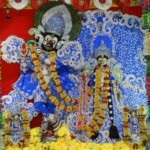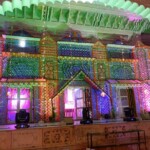
Vrindavan, a sacred town in the heart of India, is a place where spirituality and devotion merge seamlessly. One of the most revered temples in this divine town is the Shri Radha Shyamsundar Ji Temple. This temple holds a special place in the hearts of devotees who flock here to witness the divine love story of Radha and Lord Krishna. In this blog, we will explore the history, timings, entry fee, and aarti timings of this magnificent temple.
Radha Shyam Sundar Temple Vrindavan Timings
| Monday | |
| Tuesday | |
| Wednesday | |
| Thursday | |
| Friday | |
| Saturday | |
| Sunday |
Radha Shyam Sundar Temple Vrindavan Aarti Timings
| Mangala Aarti | 4:00 am |
| Dhupa Aarti | 8:15 am |
| Shringar Aarti | 10:30 am |
| Raj Bhog Aarti | 11:30 am |
| Gvala Aarti | 4:15 pm |
| Sandhya Aarti | 6:15 pm |
| Shayana Aarti | 9:00 pm |
History of Shri Radha Shyamsundar Ji Temple Vrindavan
The Shri Radha Shyamsundar Ji Temple in Vrindavan boasts a rich and captivating history steeped in the divine love story of Radha and Lord Krishna. This sacred temple is not just a place of worship but a testament to the eternal romance and devotion that permeates the town of Vrindavan. Here, we delve into the history of this magnificent temple.
The origins of the Shri Radha Shyamsundar Ji Temple can be traced back to the 16th century. It is believed that the temple was established by a revered saint named Shri Gopinath Ji, who played a significant role in the Chaitanya tradition of devotion. His divine vision and unwavering faith in Lord Krishna led to the creation of this temple, which would go on to become a center of spirituality and devotion.
Legend has it that Shri Gopinath Ji received explicit instructions from Lord Krishna himself in a vision. In this divine revelation, Lord Krishna directed Shri Gopinath Ji to build a temple dedicated to Radha and Him in Vrindavan, the very heart of Krishna’s earthly pastimes. This temple was to serve as a manifestation of their eternal love and devotion for each other.
With deep devotion and unshakable determination, Shri Gopinath Ji embarked on the mission of building the temple. Over time, the Shri Radha Shyamsundar Ji Temple became a beacon of spiritual enlightenment and a pilgrimage site for devotees from far and wide.
The temple’s architecture and design reflect the traditional North Indian style, with intricate carvings and beautiful sculptures adorning its walls. The sanctum sanctorum houses the divine idols of Radha and Lord Krishna, the main deities of the temple. These idols are lovingly adorned and worshipped daily, drawing devotees into a world of divine love and devotion.
Over the centuries, the Shri Radha Shyamsundar Ji Temple has withstood the test of time, witnessing the ebb and flow of history while remaining a constant source of spiritual solace for countless devotees. Its halls have echoed with the prayers and hymns of seekers who come to seek the blessings of Radha and Krishna, longing to experience the divine love that the temple symbolizes.
Today, the Shri Radha Shyamsundar Ji Temple stands as a living testament to the enduring love story of Radha and Lord Krishna. It continues to inspire and uplift the spirits of those who visit, reminding them of the timeless bond between the divine couple and the boundless devotion that transcends earthly boundaries. This temple’s history is a story of unwavering faith, divine guidance, and the eternal love that continues to resonate in the sacred town of Vrindavan.
Radha Shyam Sundar Temple Vrindavan Entry Fee
The Shri Radha Shyamsundar Ji Temple in Vrindavan typically does not charge an entry fee for visitors to have darshan (viewing of the deities) or to enter the temple premises. The temple is open to all devotees and visitors, and there is usually no formal entry fee required to access the main temple area.
Image Gallery of Shri Radha Shyamsundar Ji Temple Vrindavan
Things to do at Shri Radha Shyamsundar Ji Temple Vrindavan
Visiting the Shri Radha Shyamsundar Ji Temple in Vrindavan offers not only a spiritual experience but also a chance to immerse yourself in the rich cultural and religious heritage of this sacred town. Here are some things you can do and experience at the Shri Radha Shyamsundar Ji Temple:
1. Darshan (Viewing the Deities):
The primary reason for visiting any temple is to have darshan of the deities. At this temple, you can witness the beautifully adorned idols of Radha and Lord Krishna. Take your time to offer your prayers, meditate, and soak in the divine atmosphere.
2. Attend Aarti:
Participating in the temple’s aarti ceremonies is a must-do experience. The aarti rituals are performed multiple times a day, each with its own significance. These ceremonies are a feast for the senses, with melodious bhajans, fragrant incense, and the divine glow of oil lamps.
3. Explore the Architecture:
The temple’s architecture is a work of art in itself. Marvel at the intricate carvings, beautiful sculptures, and the exquisite design that reflects traditional North Indian temple architecture.
4. Learn About the Temple’s History:
As mentioned earlier, the temple has a fascinating history. You can inquire with the temple priests or guides to learn more about its origins, legends, and the role it has played in the spiritual history of Vrindavan.
5. Participate in Bhajans and Kirtans:
Many temples, including the Shri Radha Shyamsundar Ji Temple, host bhajans (devotional songs) and kirtans (musical prayers). Join in these sessions to experience the uplifting power of devotional music and chanting.
6. Take a Quiet Stroll:
The temple complex often provides serene and peaceful surroundings. Take a quiet stroll in the temple gardens or courtyards, allowing yourself some time for introspection and meditation.
7. Offer Prayers and Seek Blessings:
Devotees often bring offerings like flowers, fruits, or sweets to offer to the deities. You can participate in this tradition and seek blessings for your well-being and spiritual journey.
8. Attend Special Festivals:
If you’re visiting during a festival, such as Janmashtami (Lord Krishna’s birthday) or Radhashtami (Radha’s appearance day), the temple will be adorned with even more grandeur. Attending these festivals can be a deeply enriching experience.
9. Visit the Temple Gift Shop:
Most temples have small gift shops where you can purchase souvenirs like religious books, idols, or devotional items. These can serve as mementos of your visit or as gifts for loved ones.
10. Participate in Seva (Service):
Some temples offer the opportunity for devotees to participate in seva, which involves helping with various temple activities. This can be a gratifying way to contribute to the temple’s upkeep and spiritual mission.
Remember to be respectful of the temple’s customs and guidelines, such as appropriate attire and behavior. Visiting the Shri Radha Shyamsundar Ji Temple in Vrindavan can be a transformative experience, offering not only a glimpse into the spiritual realm but also a chance to connect with the rich cultural heritage of this sacred town.
Legend of Shri Radha Shyamsundar Ji Temple Vrindavan
The legend of the Shri Radha Shyamsundar Ji Temple in Vrindavan is a tale deeply intertwined with the eternal love story of Radha and Lord Krishna. This sacred temple is a testament to their divine romance, and its legend is a source of inspiration for countless devotees. Here’s the legend of the Shri Radha Shyamsundar Ji Temple:
The story begins with Shri Gopinath Ji, a devout saint in the Chaitanya tradition of devotion, who resided in Vrindavan during the 16th century. Shri Gopinath Ji was a fervent devotee of Lord Krishna and spent his life in unwavering devotion to the deity.
One night, as Shri Gopinath Ji was absorbed in his prayers and meditation, he experienced a profound and divine vision. In this vision, Lord Krishna himself appeared before him and conveyed a sacred message. Lord Krishna instructed Shri Gopinath Ji to build a temple dedicated to Him and Radha, His beloved consort, in Vrindavan.
This divine vision was not just a casual revelation but a clear and unequivocal command from the Lord. Shri Gopinath Ji, filled with profound faith and devotion, understood that he had been chosen for a divine mission. He embraced this divine guidance with humility and unwavering determination.
With a heart full of love and devotion, Shri Gopinath Ji embarked on the monumental task of building the temple as instructed by Lord Krishna. The temple’s purpose was clear—to be a sacred abode where Radha and Krishna’s eternal love and divine connection could be celebrated and experienced by devotees.
Shri Gopinath Ji’s dedication and tireless efforts led to the establishment of the Shri Radha Shyamsundar Ji Temple in Vrindavan. The temple became a sanctuary of spiritual bliss, attracting devotees from near and far who sought to witness and partake in the divine love story of Radha and Lord Krishna.
Over time, the temple’s popularity and significance continued to grow, and it became a beacon of devotion and spirituality. Pilgrims and seekers thronged to this sacred site to offer their prayers and experience the profound sense of love and devotion that radiated from the temple.
The Shri Radha Shyamsundar Ji Temple stands today as a living embodiment of the divine love between Radha and Lord Krishna. It is a place where devotees can immerse themselves in the eternal romance of these divine beings and seek spiritual solace and enlightenment.
The legend of the Shri Radha Shyamsundar Ji Temple in Vrindavan serves as a reminder of the enduring power of faith and devotion. It is a story that continues to inspire and touch the hearts of those who visit, reinforcing the belief that love, devotion, and divine grace are the true essence of life.
The architecture of Shri Radha Shyamsundar Ji Temple Vrindavan
The architecture of the Shri Radha Shyamsundar Ji Temple in Vrindavan is a splendid example of traditional North Indian temple architecture. It reflects the rich cultural and religious heritage of the region while serving as a visual feast for visitors.
Here are the key architectural features of this magnificent temple:
1. Temple Style:
The Shri Radha Shyamsundar Ji Temple is designed in the classic North Indian temple style, which is characterized by its ornate and intricate details. It follows the traditional Nagara architectural style, often seen in temples dedicated to Lord Krishna.
2. Temple Layout:
The temple complex comprises multiple structures, including the main sanctum sanctorum (garbhagriha) where the idols of Radha and Lord Krishna are enshrined. The temple is surrounded by a spacious courtyard and smaller shrines dedicated to various deities associated with Lord Krishna’s pastimes.
3. Ornate Carvings:
The temple is adorned with exquisite stone carvings that depict various scenes from the life of Lord Krishna. These carvings are intricately detailed and showcase the exceptional craftsmanship of the artisans who built the temple.
4. Sculptures:
The exterior of the temple features beautiful sculptures of deities, divine motifs, and celestial beings. These sculptures are not only artistically significant but also convey the spiritual essence of the temple.
5. Spire (Shikhara):
The temple’s shikhara, or spire, is a prominent feature of its architecture. It rises majestically above the sanctum sanctorum and is often adorned with decorative motifs and sculptures. The shikhara’s design is a hallmark of North Indian temple architecture.
6. Dome:
The central dome of the temple is another architectural highlight. It is typically adorned with intricate artwork and often features a kalasha (decorative pot) on top, symbolizing purity and divinity.
7. Colorful Frescoes:
Inside the temple, you can find colorful frescoes or wall paintings that narrate stories from Hindu mythology, particularly those related to Lord Krishna’s leelas (divine play). These paintings add to the temple’s aesthetic appeal and convey the spiritual teachings through art.
8. Courtyard:
The temple’s courtyard is a spacious area where devotees can gather, meditate, and participate in various rituals and ceremonies. It often features beautifully landscaped gardens and pathways.
9. Temple Tower (Rajagopuram):
Some North Indian temples, including the Shri Radha Shyamsundar Ji Temple, may have an imposing temple tower or rajagopuram at the entrance. This tower serves as a grand entrance and is often intricately decorated.
10. Devotee Amenities:
In addition to its architectural beauty, the temple complex may provide facilities for devotees, such as resting areas, a prasadam (food offering) distribution center, and areas for congregational singing and chanting.
The architecture of the Shri Radha Shyamsundar Ji Temple is a testament to the devotion and artistic prowess of those who built it. It creates an atmosphere of spiritual serenity and reverence, inviting visitors to immerse themselves in the divine love and beauty of Radha and Lord Krishna, making it a must-visit destination for both pilgrims and lovers of art and architecture.
Importance of the Shri Radha Shyamsundar Ji Temple Vrindavan
The Shri Radha Shyamsundar Ji Temple in Vrindavan holds immense significance in the hearts of devotees and spiritual seekers alike. Its importance transcends mere religious boundaries and extends to the realm of culture, history, and spirituality.
Here are some key aspects that highlight the importance of this revered temple:
- Eternal Love Story: The temple is dedicated to Radha and Lord Krishna, the divine couple whose love story is celebrated as the epitome of divine love and devotion. It serves as a living symbol of their eternal romance, reminding devotees of the profound spiritual connection between Radha and Krishna.
- Spiritual Pilgrimage: Vrindavan is considered one of the holiest places in Hinduism, and the Shri Radha Shyamsundar Ji Temple is a significant pilgrimage site within this sacred town. Devotees from all over the world visit the temple to seek spiritual solace, offer their prayers, and deepen their connection with the divine.
- Cultural Heritage: The temple’s architectural beauty and intricate carvings showcase the rich cultural heritage of North India. It stands as a testament to the craftsmanship and artistic excellence of the region, offering a glimpse into the cultural and architectural traditions of the area.
- Religious Practices: The temple conducts daily rituals, including aartis and bhajans, providing devotees with an opportunity to engage in religious practices that foster devotion and spiritual growth. These rituals are an integral part of the temple’s spiritual importance.
- Teaching Love and Devotion: The Shri Radha Shyamsundar Ji Temple serves as a spiritual and moral beacon, teaching the values of love, devotion, and selfless surrender to the divine. Devotees are inspired to emulate the selfless love of Radha for Lord Krishna in their own lives.
- Festivals and Celebrations: The temple plays a central role in celebrating various Hindu festivals, particularly Janmashtami (Lord Krishna’s birthday) and Radhashtami (Radha’s appearance day). These celebrations are marked by grand processions, bhajans, and elaborate decorations, drawing large crowds of devotees.
- Divine Energy and Blessings: Devotees believe that the temple is a reservoir of divine energy and blessings. Many seek solace, guidance, and answers to their prayers by visiting and offering their heartfelt devotion at the temple.
- Preservation of Tradition: The temple’s continued existence and its adherence to traditional customs and rituals contribute to the preservation and promotion of the Vrindavan tradition of devotion to Radha and Krishna.
- Global Attraction: The Shri Radha Shyamsundar Ji Temple attracts devotees and visitors from all corners of the world, making it a symbol of universal spirituality and the transcendence of geographical and cultural boundaries.
- Service to Humanity: Many temples, including this one, are actively involved in charitable activities, such as providing food, healthcare, and education to the underprivileged. This service to humanity further underscores the temple’s importance in promoting compassion and selfless service.
The Shri Radha Shyamsundar Ji Temple in Vrindavan is not merely a place of worship but a sanctuary of love, devotion, culture, and spirituality. It serves as a constant source of inspiration for those who seek to deepen their spiritual connection and understand the profound love that exists between Radha and Lord Krishna. The temple’s significance extends beyond its physical structure, reaching deep into the hearts and souls of all who visit.
Interesting Facts about Shri Radha Shyamsundar Ji Temple Vrindavan
The Shri Radha Shyamsundar Ji Temple in Vrindavan is a place rich in history, culture, and spirituality. Here are some interesting facts about this sacred temple that make it a unique and revered destination:
- Divine Love Story: The temple is dedicated to Radha and Lord Krishna, whose love story is the stuff of legends. It celebrates their divine and eternal love, making it a significant pilgrimage site for devotees of Lord Krishna.
- Founded by Shri Gopinath Ji: The temple was established by Shri Gopinath Ji, a prominent saint in the Chaitanya tradition during the 16th century. His devotion to Lord Krishna and the divine vision that inspired him to build the temple are central to its history.
- Visiting Place of Saints: Over the centuries, the Shri Radha Shyamsundar Ji Temple has been visited by numerous saints, sages, and spiritual leaders who have been drawn to its spiritual aura. Their blessings and presence have enriched the temple’s significance.
- Aartis Throughout the Day: The temple conducts multiple aarti ceremonies throughout the day, allowing devotees to participate in these rituals and experience the divine atmosphere. Each aarti has its unique significance, adding to the spiritual experience.
- Mangala Aarti at Sunrise: The Mangala Aarti, performed at sunrise, is a serene and spiritually uplifting experience that marks the awakening of the deities. The temple often gets bathed in the golden glow of the morning sun during this ritual.
- Beautiful Architecture: The temple’s architecture is a blend of traditional North Indian temple design and intricate stone carvings. The intricate details and craftsmanship are a testament to the artistry of the time.
- Cultural Significance: The temple showcases the cultural and religious heritage of Vrindavan, making it not just a place of worship but also a cultural landmark of the region.
- Pilgrimage Destination: Devotees and tourists from around the world flock to the temple to seek blessings, witness the divine love of Radha and Krishna, and participate in the vibrant spiritual atmosphere of Vrindavan.
- Janmashtami Celebrations: The temple celebrates Janmashtami, Lord Krishna’s birthday, with great fervor and grand processions. It’s a time when the temple comes alive with bhajans, dances, and special rituals.
- Radhashtami Observance: Radhashtami, the appearance day of Radha, is another major celebration at the temple. Devotees express their love and devotion to Radha through prayers and festivities.
- Spiritual Teachings: The temple offers a platform for spiritual teachings and discourses, allowing visitors to deepen their understanding of the Bhakti (devotional) tradition and the philosophy of love and devotion.
- Service to Humanity: Many charitable activities are undertaken by the temple authorities, including providing meals to the needy and supporting educational initiatives, reflecting the temple’s commitment to service.
The Shri Radha Shyamsundar Ji Temple in Vrindavan is not just a religious site but a vibrant hub of spirituality, culture, and devotion. Its history, rituals, and unique ambiance make it a place where the divine love of Radha and Lord Krishna come alive, leaving an indelible impression on all who visit.
Festivals at Shri Radha Shyamsundar Ji Temple Vrindavan
The Shri Radha Shyamsundar Ji Temple in Vrindavan celebrates various festivals with great enthusiasm and devotion, adding to its vibrancy and spiritual significance.
Here are some of the major festivals observed at the temple:
- Janmashtami: Janmashtami, the birthday of Lord Krishna, is one of the grandest celebrations at the Shri Radha Shyamsundar Ji Temple. Devotees from all over the world gather to commemorate this auspicious occasion. The temple is beautifully decorated, and a variety of rituals, bhajans, and cultural programs take place. The main highlight is the midnight abhishekam (bathing ceremony) of the deity, followed by joyous celebrations.
- Radhashtami: Radhashtami marks the appearance day of Radha, Lord Krishna’s divine consort. It is a significant celebration at the temple, reflecting the importance of Radha’s devotion and love. Devotees express their love for Radha through prayers, bhajans, and special offerings.
- Holi: Holi, the festival of colors, is celebrated with great enthusiasm in Vrindavan, known as the land of Lord Krishna’s childhood pastimes. At the Shri Radha Shyamsundar Ji Temple, Holi is celebrated with colorful processions, the throwing of colored powders, and devotional singing. It’s a joyful occasion that resonates with Lord Krishna’s playful spirit.
- Diwali: Diwali, the festival of lights, is observed with the lighting of oil lamps and diyas (earthen lamps) throughout the temple complex. The temple is adorned with colorful decorations, and devotees offer prayers for prosperity and spiritual enlightenment.
- Annakut: Annakut is a special festival celebrated on the day following Diwali. It involves arranging a mountain-like offering of various food items before the deities. Devotees believe it symbolizes Lord Krishna’s lifting of Mount Govardhan to protect the residents of Vrindavan from Indra’s wrath.
- Gopashtami: Gopashtami commemorates the day when Lord Krishna, as a young boy, was given charge of the cows and became a qualified cowherd. Devotees at the temple celebrate this event with special prayers and offerings.
- Radha Ashtami: Radha Ashtami is the celebration of Radha’s appearance day, emphasizing her role as the supreme devotee of Lord Krishna. Devotees offer special pujas, bhajans, and prayers to seek her blessings.
- Sharad Purnima: Sharad Purnima is the full moon night in the autumn season, celebrated as a special day in Vrindavan. Devotees believe that Lord Krishna performed the famous Rasa Lila dance with the gopis on this night. At the temple, it is observed with devotional singing and dancing.
- Kartik Month: The entire month of Kartik (October-November) is considered highly auspicious in Vrindavan, with special pujas, aarti ceremonies, and fasting observed by devotees. Lighting lamps and offering prayers in the temple during this month are believed to bring immense spiritual merit.
These festivals at the Shri Radha Shyamsundar Ji Temple not only celebrate the divine pastimes of Radha and Lord Krishna but also offer devotees an opportunity to deepen their spiritual connection and experience the rich cultural heritage of Vrindavan. Each festival is a colorful and joyous occasion that attracts pilgrims and tourists alike, making the temple a vibrant center of devotion and celebration.
Places to visit near Shri Radha Shyamsundar Ji Temple Vrindavan
Vrindavan is a town steeped in spirituality and history, and there are several notable places to visit near the Shri Radha Shyamsundar Ji Temple that offer a deeper insight into the religious and cultural heritage of the region.
Here are some of the must-visit places nearby:
Banke Bihari Temple:

This temple is dedicated to Lord Krishna as Banke Bihari, renowned for its unique idol of Lord Krishna with arms bent at the elbows, symbolizing his willingness to embrace his devotees. The temple is known for its vibrant atmosphere, especially during the evening aarti.
Prem Mandir:
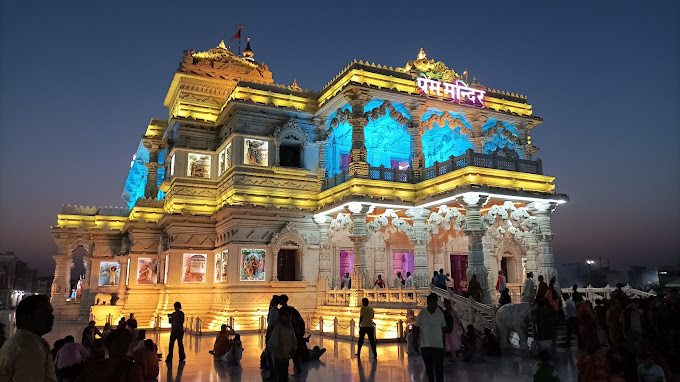
The Prem Mandir is a relatively new addition to Vrindavan’s spiritual landscape. This temple is an architectural marvel, adorned with intricate marble carvings depicting the divine pastimes of Radha and Krishna. The temple’s illumination in the evenings is a visual treat.
ISKCON Temple:
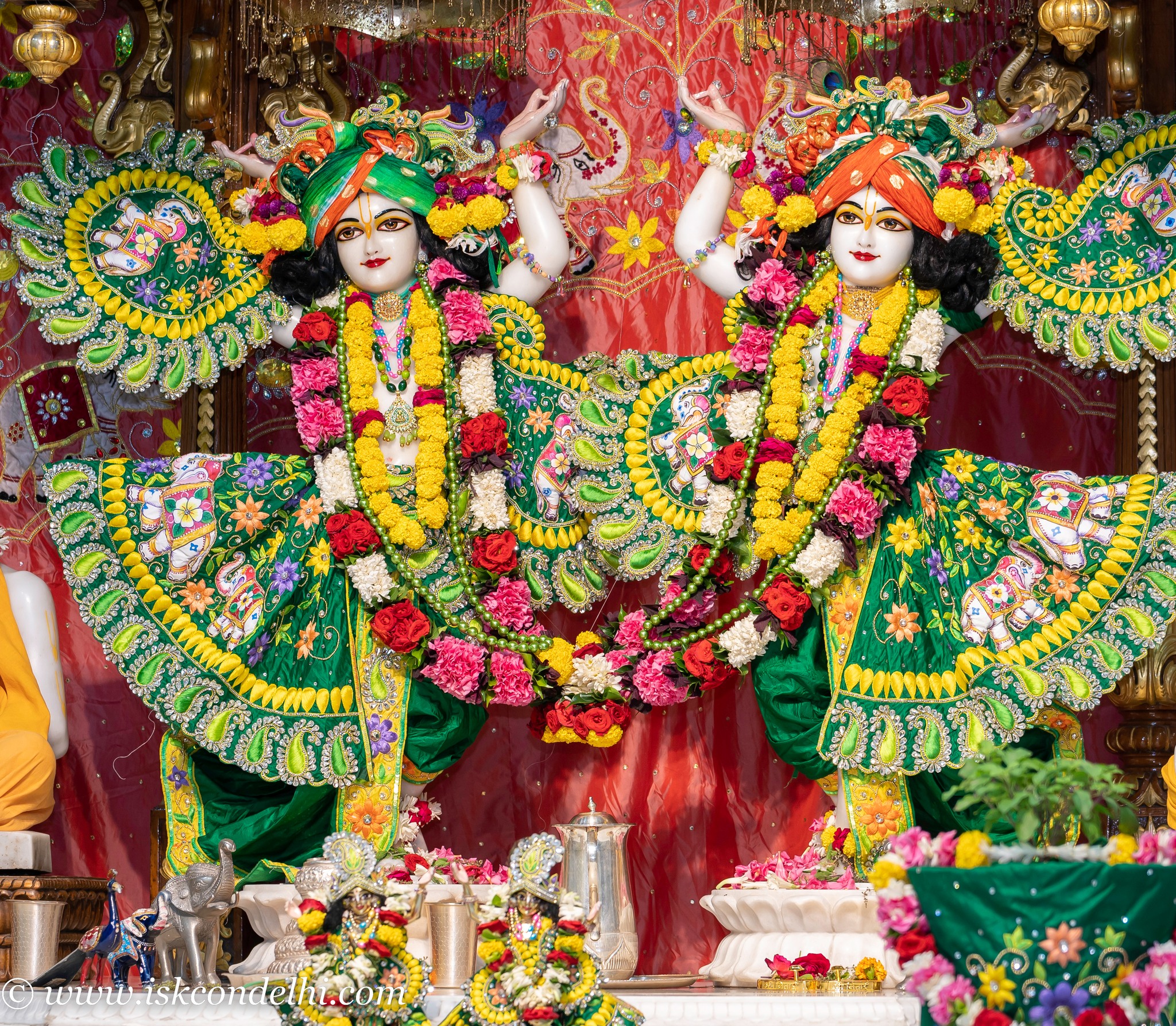
The International Society for Krishna Consciousness (ISKCON) Temple in Vrindavan is a major attraction. It features beautiful deities of Radha and Krishna, a serene temple complex, a museum, and a vegetarian restaurant. It’s a hub of spiritual activities and teachings.
Radha Vallabh Temple:
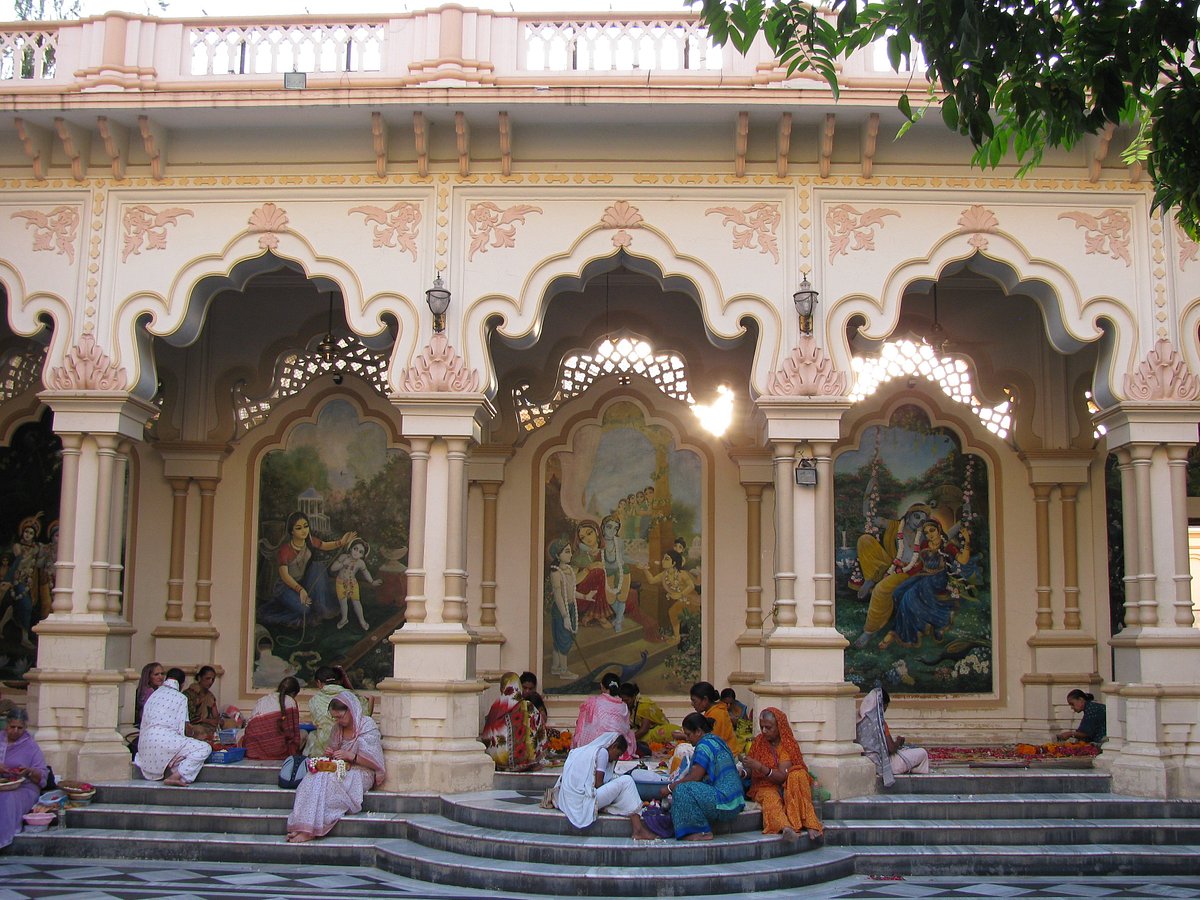
Dedicated to Lord Krishna’s beloved Radha, this temple is known for its unique tradition of dressing the deity in new garments every day. The temple’s serene ambiance and devotion-filled atmosphere make it a must-visit.
Govind Dev Temple:
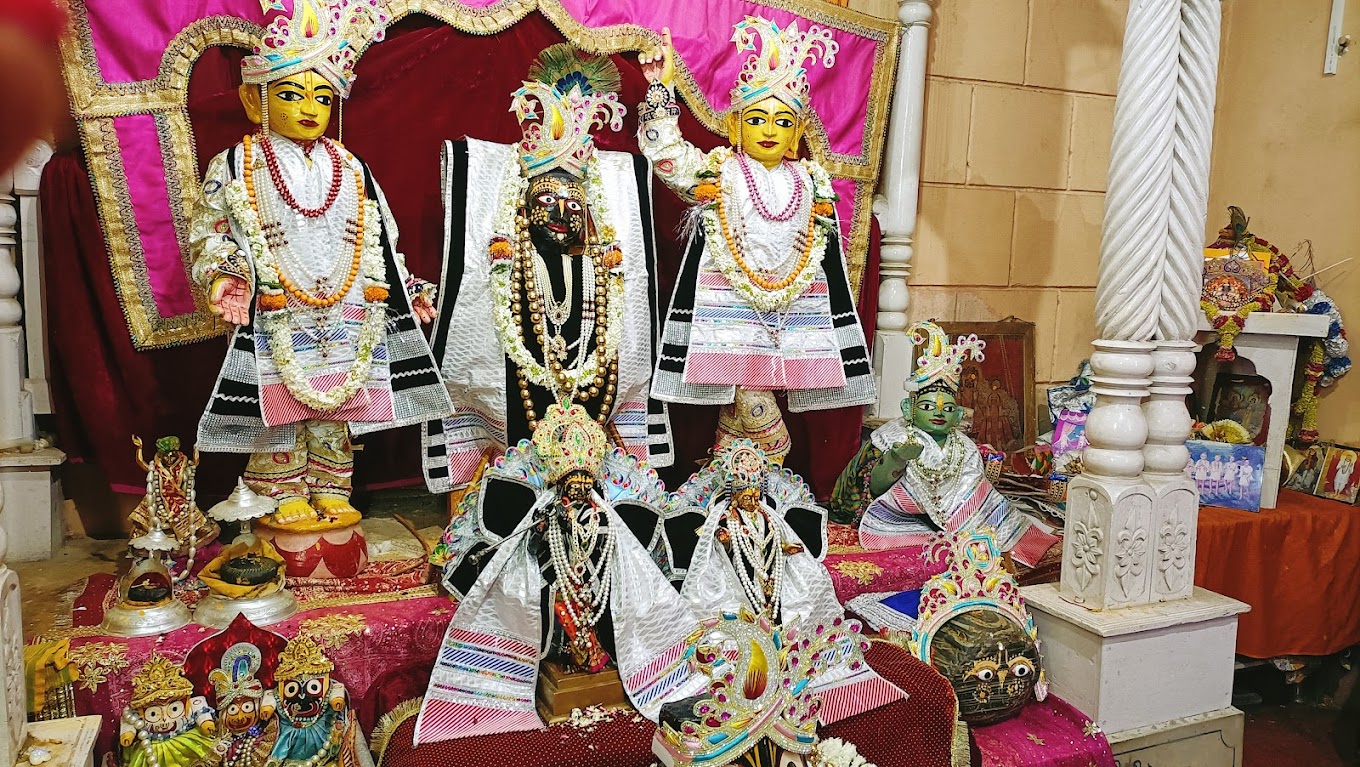
This historic temple is known for its stunning architecture and intricate frescoes. It was once a royal temple patronized by the Mughal emperor Akbar. The temple’s deity, Lord Krishna as Govind Dev, is beautifully adorned.
Rangaji Temple:
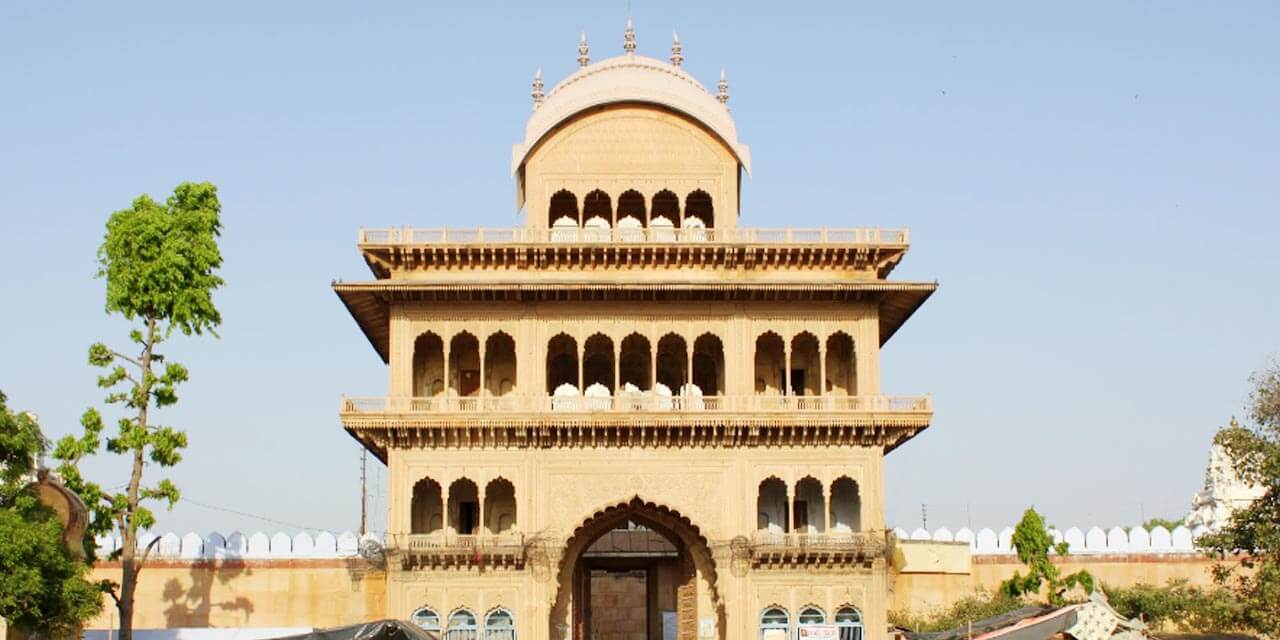
This temple is dedicated to Lord Ranganatha, a form of Lord Vishnu reclining on the serpent Ananta. Its distinctive South Indian architectural style sets it apart from other temples in Vrindavan.
Kesi Ghat:

Located on the banks of the Yamuna River, Keshi Ghat is believed to be the site where Lord Krishna defeated the demon horse, Kesi. It’s a peaceful place to take a dip in the holy river and experience the spiritual energy of Vrindavan.
Radha Gokulananda Temple:
This temple, affiliated with ISKCON, is known for its beautiful deities of Radha and Krishna. It’s a peaceful place for meditation and reflection.
Sriji Temple:
Also known as the Sree Radha Raman Temple, it’s one of the seven temples of Thakur of Vrindavan. The deity here is believed to be self-manifested.
Yamuna River Ghats:
The ghats along the Yamuna River provide a tranquil setting for meditation, reflection, and taking part in evening aarti ceremonies. The sacred river holds immense significance in Hindu mythology.
Seva Kunj:

This secluded garden is believed to be the place where Lord Krishna performed his rasa dance with Radha and the gopis. It’s a peaceful spot for devotees to immerse themselves in devotion and prayer.
Madan Mohan Temple:
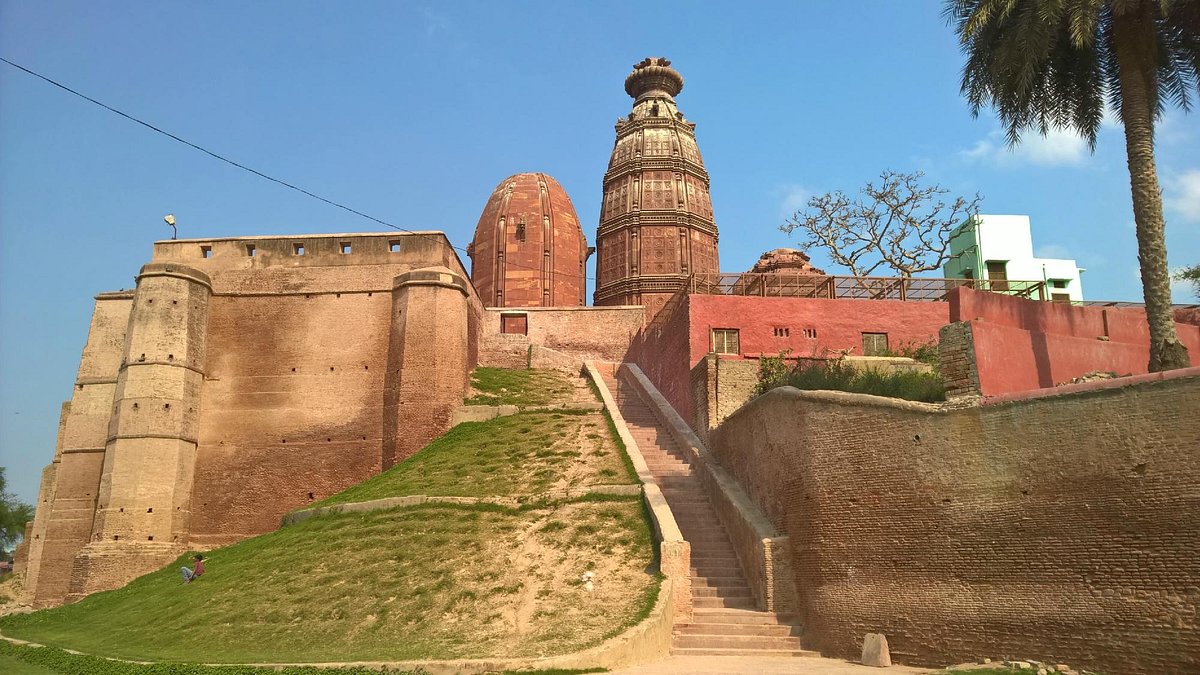
This temple, dedicated to Lord Krishna, is one of the oldest temples in Vrindavan. It’s known for its ancient deity and beautiful architecture.
These are just a few of the many sacred and historic sites near the Shri Radha Shyamsundar Ji Temple in Vrindavan. Each place offers a unique spiritual experience and a deeper connection to the divine presence of Lord Krishna and Radha in this sacred town.
Places to Eat Near Shri Radha Shyamsundar Ji Temple Vrindavan
Exploring the culinary delights near the Shri Radha Shyamsundar Ji Temple in Vrindavan can be a delightful experience. While Vrindavan is primarily a vegetarian town with a focus on sattvic (pure) food, you can still find a variety of tasty options.
Here are some places to eat near the temple:
- MVT Restaurant (MVT Bhavan): Located within the ISKCON premises, MVT Restaurant offers a range of delicious vegetarian dishes. It’s known for its pure and hygienic food and is a favorite among devotees and tourists.
- Brijwasi Mithai Wala: This renowned sweet shop and restaurant chain in Vrindavan offers delectable Indian sweets (mithai) and a variety of vegetarian snacks and meals. Their samosas and sweets are particularly popular.
- Govinda Restaurant: Another dining option within the ISKCON complex, Govinda Restaurant serves wholesome and tasty vegetarian meals. The menu includes Indian, continental, and Chinese dishes.
- Raman Reti Prasadam Center: This simple and affordable eatery near the Shri Radha Shyamsundar Ji Temple serves delicious and freshly prepared vegetarian food. It’s a popular choice for devotees.
- Prem Mandir Food Court: While visiting the Prem Mandir, you can enjoy a meal at the food court, which offers a variety of vegetarian snacks and North Indian cuisine. The serene surroundings add to the dining experience.
- Indian Coffee House: Located near the Vrindavan ISKCON temple, this casual eatery offers coffee, tea, and a selection of light snacks. It’s a great place to relax and enjoy a cup of coffee.
- Gopi Vastra Bhandar: This restaurant is known for its North Indian and South Indian vegetarian dishes, as well as a selection of sweets. The thali meals are a popular choice for those looking for a complete meal.
- Bansal Bhojnalaya: A simple and budget-friendly restaurant near the temple, Bansal Bhojnalaya offers a variety of vegetarian dishes, including Indian curries, rice, and bread.
- Mukesh Vaishno Bhoj: This vegetarian restaurant is known for its quality and variety of North Indian dishes, including vegetarian thalis. It’s a good option for those looking for a satisfying meal.
- Yamuna Dosa: If you’re in the mood for South Indian cuisine, Yamuna Dosa is a popular spot. They serve a range of dosas, idlis, and vadas, along with fresh coconut chutney and sambar.
- Santushti Restaurant: Located a short distance from the temple, this restaurant offers a mix of Indian and Chinese vegetarian dishes. The rooftop seating provides a pleasant dining experience.
- Bhagwati Bhoj: A no-frills restaurant known for its quick service and affordable North Indian vegetarian dishes. It’s a convenient option for a satisfying meal.
Please note that Vrindavan is a sacred town with a strong vegetarian tradition, and many restaurants may not serve non-vegetarian food or alcohol. However, you can enjoy a wide range of flavorful and wholesome vegetarian dishes that reflect the spiritual and cultural essence of the town.
Places to Stay Near Shri Radha Shyamsundar Ji Temple Vrindavan
Finding comfortable accommodation near the Shri Radha Shyamsundar Ji Temple in Vrindavan is relatively easy, with options ranging from budget hotels to more upscale establishments.
Here are some places to stay near the temple:
- MVT Bhaktivedanta Ashram: Located within the ISKCON premises, this ashram offers clean and comfortable rooms with modern amenities. It’s an ideal choice for those seeking a peaceful and spiritual atmosphere.
- Krishna Bhumi Holydays: Krishna Bhumi offers a range of accommodation options, from budget rooms to luxurious suites, with a beautiful view of the Krishna theme park. It’s a convenient choice for families and groups.
- Hotel Basera Brij Bhoomi: This budget-friendly hotel is located near the temple and offers clean rooms and a restaurant serving vegetarian meals. It’s suitable for travelers looking for a comfortable stay without breaking the bank.
- Brijwasi Royal Hotel: A well-known hotel chain in Vrindavan, Brijwasi Royal Hotel provides comfortable rooms with modern amenities. It also has a vegetarian restaurant and a banquet hall for events.
- Hotel Santosh Dham: This hotel is known for its convenient location and friendly staff. It offers a range of room categories to suit different budgets and preferences.
- Nidhivan Sarovar Portico: Located a short drive from the temple, this hotel offers comfortable rooms, a restaurant, and conference facilities. It’s a good option for business travelers and tourists alike.
- Mukund Palace: A budget hotel with clean rooms and a restaurant serving vegetarian cuisine. It’s conveniently located near the temple and offers basic amenities.
- Hotel The Shubham: This budget-friendly hotel provides clean and comfortable rooms with a restaurant serving Indian and Chinese vegetarian dishes. It’s a short distance from the temple.
- Hotel Ananda Krishna Van: This hotel offers comfortable rooms and a peaceful ambiance. It’s a suitable choice for those seeking a serene stay near the temple.
- Hotel Vrinda Palace Seva Dham: A budget hotel offering clean rooms and a vegetarian restaurant. It’s within walking distance of the Shri Radha Shyamsundar Ji Temple.
- Vrindavan Garden Guest House: This guest house is known for its peaceful surroundings and budget-friendly rates. It offers basic amenities and a serene atmosphere.
- Hotel Vrindavan Dham: Situated near the temple, this hotel offers comfortable rooms and a restaurant serving vegetarian meals. It’s a convenient choice for pilgrims and tourists.
When booking accommodation in Vrindavan, it’s advisable to check for availability and reviews, especially during peak pilgrimage seasons and festivals. Whether you’re seeking a tranquil ashram experience or a comfortable hotel stay, there are options to suit various budgets and preferences near the Shri Radha Shyamsundar Ji Temple.
Best Time to Visit Shri Radha Shyamsundar Ji Temple Vrindavan
The best time to visit the Shri Radha Shyamsundar Ji Temple in Vrindavan largely depends on your preferences and the kind of experience you seek. Vrindavan experiences different seasons, each offering a unique atmosphere.
Here’s a breakdown of the best times to visit the temple:
- Winter (October to February): The winter months are considered one of the best times to visit Vrindavan. The weather is cool and pleasant, making it comfortable for temple visits and outdoor exploration. This is also the festival season, with Diwali, Govardhan Puja, and other celebrations adding to the festive spirit.
- Spring (March to April): Spring in Vrindavan is characterized by mild temperatures and blooming flowers, creating a picturesque setting. The annual Holi festival, celebrated with enthusiasm, usually falls during this season, attracting visitors from all over.
- Early Summer (May to June): While temperatures begin to rise during this period, it can still be a good time to visit if you prefer fewer crowds. Early morning and late evening visits to the temple are more comfortable due to cooler temperatures.
- Monsoon (July to September): Monsoon brings heavy rainfall to Vrindavan. While the town looks lush and green during this time, the temple visits may be interrupted by rain, and the roads can get muddy. It’s a quieter season for tourists but not ideal for outdoor activities.
- Late Summer (September to October): The late summer months can be warm and humid. However, this is the time when Radhashtami, the appearance day of Radha, is celebrated with grandeur in Vrindavan. If you plan to visit for this festival, be prepared for warm weather.
To avoid the peak crowds during festivals like Janmashtami and Radhashtami, consider arriving a few days before or after the actual celebration date. Also, keep in mind that Vrindavan is a popular pilgrimage destination, so it tends to be busier during weekends and major religious events.
The months of October to March offer the most comfortable weather for temple visits and sightseeing. However, if you wish to experience the vibrant and colorful festivals of Vrindavan, especially Holi and Janmashtami, you may choose to visit during the respective festival seasons, even if the weather is warmer.
How to Reach Shri Radha Shyamsundar Ji Temple Vrindavan
Reaching the Shri Radha Shyamsundar Ji Temple in Vrindavan is relatively straightforward, as Vrindavan is well-connected by road and rail to major cities in India.
Here are the primary modes of transportation and directions to reach the temple:
By Train:
- Mathura Junction (MTJ): Mathura, the neighboring city to Vrindavan, has a major railway station called Mathura Junction (MTJ). Many long-distance trains from major Indian cities, including Delhi, Agra, Jaipur, and Mumbai, halt at Mathura Junction. From Mathura Junction, you can easily hire a taxi or an auto-rickshaw to reach Vrindavan, which is just about 10 kilometers away.
By Road:
- From Delhi: Vrindavan is approximately 150 kilometers from Delhi, and you can reach it by road via the Yamuna Expressway. It takes around 3-4 hours by car. You can also opt for state-run buses or private buses that operate between Delhi and Vrindavan.
- From Agra: Agra, famous for the Taj Mahal, is around 70 kilometers from Vrindavan. You can hire a taxi or take a bus from Agra to Vrindavan. The journey usually takes around 2 hours.
Local Transportation in Vrindavan:
- Auto-rickshaws: Auto-rickshaws are a popular mode of transportation within Vrindavan. They are convenient for short-distance travel within the town and can take you to the Shri Radha Shyamsundar Ji Temple from various points in Vrindavan.
- Cycle-Rickshaws: Cycle-rickshaws are another eco-friendly option for moving around Vrindavan. They are suitable for exploring the narrow lanes and alleys of the town.
- Taxis: Taxis are available for hire, and you can also book them for a full-day tour of Vrindavan and nearby places.
Walking: Vrindavan is a compact town, and many of the temples and attractions are within walking distance of each other. Walking can be a pleasant way to explore the town at a leisurely pace.
The Shri Radha Shyamsundar Ji Temple is located in the heart of Vrindavan, and you can easily reach it by various modes of transportation once you are in the town. It’s advisable to ask locals or your accommodation provider for specific directions to the temple, as Vrindavan’s lanes and bylanes can be intricate to navigate.
Google Map Radha Shyam Sundar Temple Vrindavan
FAQs about the Shri Radha Shyamsundar Ji Temple in Vrindavan
What are the temple's opening hours?
The temple typically opens early in the morning for Mangala Aarti (around 4:30 AM or 5:00 AM) and closes after the Shayan Aarti in the evening (around 8:30 PM or 9:00 PM). However, it's advisable to confirm the current timings before your visit.
Is there an entry fee to visit the temple?
Generally, there is no entry fee to visit the main temple area. Entry is free for darshan (viewing of the deities). However, there may be fees associated with specific services or events within the temple complex.
Can I take photographs inside the temple?
Photography policies may vary, but in many temples, photography and videography may be restricted or prohibited inside the sanctum sanctorum where the deities are located. It's best to inquire about photography rules at the temple entrance.
Are there any dress code requirements for visiting the temple?
While there may not be a strict dress code, it is respectful to wear modest and appropriate clothing when visiting a temple. It's advisable to dress conservatively, covering shoulders and knees, as a sign of respect for the sacred environment.
Are there any specific rules or rituals I should be aware of when visiting the temple?
Temples often have specific rules and rituals, such as removing shoes before entering the sanctum sanctorum and maintaining silence and reverence within the temple premises. It's a good practice to observe and follow these customs.
Can non-Hindus visit the Shri Radha Shyamsundar Ji Temple?
Yes, the temple is open to people of all faiths and backgrounds. Visitors of any religion or nationality are welcome to experience the spiritual atmosphere and culture of the temple.
Is there a particular time of the year when the temple is most crowded or during a festival?
The temple can be particularly crowded during major Hindu festivals like Janmashtami (Lord Krishna's birthday) and Radhashtami (Radha's appearance day). It's advisable to plan your visit accordingly if you wish to be part of these celebrations or to avoid large crowds.
Are there any nearby attractions or places to visit in Vrindavan?
Yes, Vrindavan is known for its numerous temples, ghats, and sacred sites associated with Lord Krishna. Some nearby attractions include the Banke Bihari Temple, Prem Mandir, and the ISKCON Temple.
Is there any accommodation available near the Shri Radha Shyamsundar Ji Temple?
Yes, Vrindavan offers a range of accommodation options, including ashrams, guesthouses, and hotels, for visitors seeking places to stay near the temple. It's advisable to book your accommodation in advance, especially during peak seasons and festivals.
What is Radha Shyam Sundar Temple Vrindavan Timings?
| Day | Timing |
| Monday | 4:00 am – 12:00 pm |
| 6:00 pm – 10:00 pm | |
| Tuesday | 4:00 am – 12:00 pm |
| 6:00 pm – 10:00 pm | |
| Wednesday | 4:00 am – 12:00 pm |
| 6:00 pm – 10:00 pm | |
| Thursday | 4:00 am – 12:00 pm |
| 6:00 pm – 10:00 pm | |
| Friday | 4:00 am – 12:00 pm |
| 6:00 pm – 10:00 pm | |
| Saturday | 4:00 am – 12:00 pm |
| 6:00 pm – 10:00 pm | |
| Sunday | 4:00 am – 12:00 pm |
| 6:00 pm – 10:00 pm |
Radha Shyam Sundar Temple Vrindavan Darshan & Aarti Timings
| Darshan Timings | Aarti Timings |
| 4:00 am to 4:15 am | 4:00 am - Mangala Aarti |
| 6:30 am to 8:20 am | 8:15 am - Dhupa Aarti |
| 8:30 am to 10:35 am | 10:30 am - Shringar Aarti |
| 11:30 am to 11:45 am | 11:30 am - Raj Bhog Aarti |
| 4:15 pm to 6;15 pm | 4:15 pm - Gvala Aarti |
| 6:15 pm to 8:00 pm | 6:15 pm - Sandhya Aarti |
| 9:00 pm to 9:15 pm | 9:00 pm - Shayana Aarti |
What is the nearest major railway station to Shri Radha Shyamsundar Ji Temple in Vrindavan?
The nearest major railway station is Mathura Junction (MTJ). Many long-distance trains from cities like Delhi, Agra, Jaipur, and Mumbai halt at Mathura Junction.
How far is Vrindavan from Mathura Junction railway station?
Vrindavan is located at a distance of approximately 10 kilometers (about 6.2 miles) from Mathura Junction railway station. You can easily reach Vrindavan from Mathura Junction by hiring a taxi or an auto-rickshaw.
Are there bus services from nearby cities to Vrindavan?
Yes, there are bus services that connect nearby cities like Delhi, Agra, and Mathura to Vrindavan. State-run buses and private operators offer regular services to and from Vrindavan.
Can I hire a taxi or auto-rickshaw from Mathura Junction to Shri Radha Shyamsundar Ji Temple?
Yes, you can hire a taxi or an auto-rickshaw from Mathura Junction railway station to reach Shri Radha Shyamsundar Ji Temple in Vrindavan. It's a convenient mode of transportation for travelers.
What is the approximate travel time by road from Mathura Junction to Shri Radha Shyamsundar Ji Temple in Vrindavan?
The travel time by road from Mathura Junction to Shri Radha Shyamsundar Ji Temple in Vrindavan is approximately 20-30 minutes, depending on traffic conditions.
Are there any local transportation options within Vrindavan for getting around?
Yes, within Vrindavan, you can use local transportation options like auto-rickshaws and cycle-rickshaws for short-distance travel. Many of the town's attractions are within walking distance as well.
Is Vrindavan easily accessible by car from nearby cities like Delhi and Agra?
Yes, Vrindavan is accessible by car from nearby cities like Delhi and Agra. The Yamuna Expressway provides a convenient and well-maintained road connection to Vrindavan.
Are there parking facilities available near Shri Radha Shyamsundar Ji Temple?
Yes, there are parking facilities available near the temple for visitors who arrive by car or two-wheeler.
Can I get directions to Shri Radha Shyamsundar Ji Temple using GPS or navigation apps?
Yes, you can use GPS or navigation apps to get directions to Shri Radha Shyamsundar Ji Temple in Vrindavan. Most navigation apps provide accurate guidance to reach the temple.
Is it advisable to check for traffic and road conditions before traveling to Vrindavan?
Yes, it's advisable to check for traffic updates and road conditions, especially if you are traveling during peak hours or the festival season. This can help you plan your journey more efficiently.

